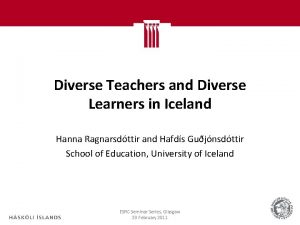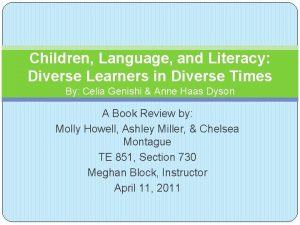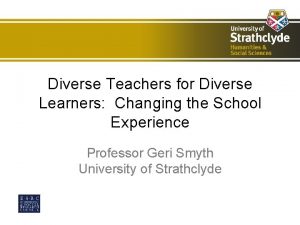Good teaching for diverse learners 1 Focus on







- Slides: 7

Good teaching for diverse learners 1. Focus on students as learners 2. Respect and adjust for diversity 3. Provide context-specific information and support 4. Facilitate meaningful intercultural dialogue and engagement 5. Be adaptable, flexible and responsive to evidence 6. Prepare students for life in a globalised world NEXT

Principle 1: Good teaching across diverse learners will focus on students as learners Assessment Drives students learning/ their discipline-specific knowledge/ and skills & also confirms students understanding of what they are required to do to meet the assessment requirements. How can assessors focus on diverse students as learners? Skills like critical reading and writing use of examples as evidence how to structure an ‘essay’, or a ‘case study’ not presumed to be present at enrolment What next? ü Provide them with resources & guidance (referencing requirements). ü Provide specific feedback and support students who need support to develop academic language. ü Provide linkage of learning material and the purpose of learning (rationale) and its use in examination. Click here to go to the page on “Principles of good teaching” BACK NEXT

Principle 2: Respect and adjust for diversity/ Know and respect your students Why? Ø Knowing your students & challenges they are facing while studying, improves retention rates and the overall success of students. Ø Students may be facing time poverty, financial pressure, family responsibility and/or significant hours of employment with study. How? Making time and space for student to contribute to class – it’s a way for staff to get to know their students and for students to get to know each other. Provide students with opportunities to clarify the requirement of an assessment task early in the course. Provide examples of coursework question along with the answers – this will help students understand what is expected. Include a range of assessment task (case-base evaluation, self-assessment, peer assessment, presentations)- this will help students to demonstrate their learning in different ways. Click here to go Provide pre-exam practice and feedback. to the page on “Principles of good teaching” BACK NEXT

Principle 3: Provide context-specific information and support Australian university populations in continue to diversify- it is necessary to teach the students in ways that accommodate all of them. Accessible language provides clear understanding of expectations, concepts, ideas and assessment requirements and facilitated higher-level understanding and performance by LSES students/ diverse students. v Example: “Write in depth”, “Critically Analyse”, “interpretation”- Student might think What’s depth? What’s critical? What’s analysis? Student’s say: “Because they are the ones marking my assessment. . It’s good to know what they want in the assessment or exam” Assessment item must be: COMPARABLE, LINKED to the LEARNING OBJECTIVES and ASSESS the SAME KNOWLEDGE and SKILLS Click here to go to the page on “Principles of good teaching” BACK NEXT

Principle 4: Good teaching across diverse learners will enable meaningful intercultural dialogue and engagement How? Include assessment tasks with small groups sizes as a part of the program (Ideally between 4 and 6 members). Provide feedback so that the students progressively develop their skills. Tell students about the rationale for working in a group. Assessment of group work includes peer assessment as well as self-assessment and reflection. When students are asked to think about what they are learning in the group process: Ø they start to look at the world from a non-selfperspective Ø they start to be more open-minded and Ø they learn intercultural interaction skills and interact with students from different backgrounds. Click here to go to the page on “Principles of good teaching” BACK NEXT

Principle 5: Be adaptable, flexible and responsive to evidence Flexibility &Variety in assessment (mode) • Part of providing flexibility and variety to students is offering different assessment formats. Flexibility around assessment due dates: A clear need for flexibility around assessment due dates at times for LSES students. Question of fairness? Responsive & adaptive: Feedback Reflecting on practice Changes are evidence based MAKE SURE THAT THE METHOD CHOSEN IS RELEVANT TO THE LEARNING OUTCOME Click here to go to the page on “Principles of good teaching” BACK NEXT

Principle 6: Preparing students for life in a globalised world Assessment tasks should: Promote learning and skills beyond the task itself/ develop the ability of the student to gather and apply knowledge in and across disciplines in a globalised world/ consider the global application; encourage life-long learning; Should let the student show that they can deal with multiple perspectives such as National, cultural and/or linguistic. Students should be taught to be reflective: Reflection can lead to important questions, use reflective task to analyse critically and reflect on their own assumptions, values and beliefs. Click here to go to the page on “Principles of good teaching” BACK












